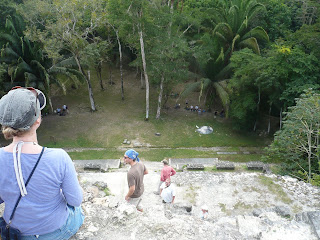
Yesterday was my first snorkeling experience, and I have to say - I may never top it.
San Pedro is about a ten minute boat ride from the second largest coral reef in the world, the picture is actually taken from a dock here on San Pedro - that white line of waves in the distance is the reef, so that's how close it is.
I met the boat at a dock about two minutes walk from the hostel where I am staying and me and an American couple were the only ones on the boat, aside from our guide who had the fortune of also being named Andy. The boat was made to seat at least 20 people, so with only four of us on board, we raced out to the reef in almost no time at all.
The reef here is part of the Hol Chan marine reserve, so if you want to take a closer look at the things that live there, you can probably find a web site for it.
I should also note that the water here, though quite warm in places (or perhaps because of it) is extremely salty, so after swimming in it you and anything you're wearing are covered in a thin layer of salt.
There were plenty of other snorkelers there, but not a crowd in any way, and there's lots of room. The water is fairly warm and ranges in depth from a few feet to about 10 meters. The coral is everywhere, and even breaks the surface in many places.
Underwater there exists a world unlike anything I have ever seen, as soon as you get in the water you are face to face with the fish - they don't like to be touched of course, but they will swim right it front of you or beside you. A short list of the kinds we saw would be ...
Rainbow and Midnight Parrot fish, A huge Barracuda and a huge Morey eel, Angelfish the size of my head, several different kinds of snappers, groupers, and a plethora of bright little fish darting in and out of the coral. Our guide also pointed out the various life that attaches itself to the coral, as well as bringing up a Sea Cucumber (kinda like a big slug) for us to see. A couple sting rays glided past while we were in the deeper waters, but a highlight for me was seeing a huge Eagle Ray gliding past. On our way back to the boat we had another highlight when we came across a couple of Green Turtles swimming in the warm shallow waters and feeding on the sea grass that grows there. We played tag for a little while, though I'm not sure they got the point of the game or enjoyed it as much as us.
People were diving as well, though to be perfectly honest it seemed rather unnecessary to me - the water is for the most part so shallow that you can stand, and the fish are always just barely out of reach.
After about 45 minutes there we headed out to what's called Shark Ray Alley. It's called that because it used to be a fishing ground for the locals, and the sharks picked up on that detail and started congregating every time they heard the boats. Now it's a protected reserve, but the guides have kept up the process of throwing some fish in for the sharks, so they've kept coming.
Now, being new to this whole experience, there are some things I had to learn. For instance, there are some parts of snorkeling that go against every part of natural instinct you posses, as I learned when, after luring a Nurse Shark about 6 feet long up to the boat by throwing fish to it, we jumped off the side into the water with it.
I have always found fish to be full of expression, don't ask me why, I just feel that way. There is wary fear in their eyes mixed with curiosity that I feel gives them a great deal of personality.
However, staring into the eyes of a six foot shark coming straight towards me made my blood run cold.
There is nothing in the eyes of a shark put cold, predatory calculation -there is no warmth, and personally I believe that comes from a complete lack of any kind of fear. So for a while we swam around with the Nurse Shark, and every time I looked in it's eyes I felt a chill run down my spine. Eventually though, it decided there was not going to be any more food, and since eating us would probably cause such a fuss, the shark went out in search of an easier meal.
And so after swimming out to another bit of coral, we returned to the boat and made our way back to shore.






























